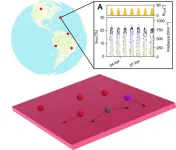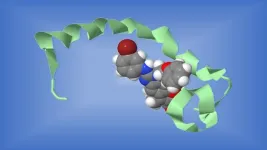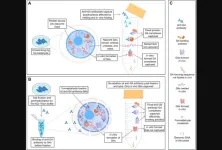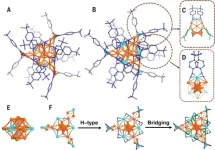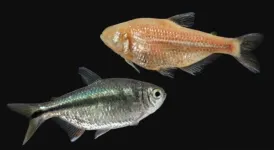(Press-News.org) Scientists at the USC Rossier School of Education’s Center for Affective Neuroscience, Development, Learning and Education (CANDLE), have shown for the first time that a type of thinking, that has been described for over a century as a developmental milestone of adolescence, may grow teenagers’ brains over time. This kind of thinking, which the study’s authors call “transcendent,” moves beyond reacting to the concrete specifics of social situations to also consider the broader ethical, systems-level and personal implications at play. Engaging in this type of thinking involves analyzing situations for their deeper meaning, historical contexts, civic significance, and/or underlying ideas.
The research team, led by USC Rossier Professor Mary Helen Immordino-Yang, includes Rebecca J.M. Gotlieb, research scientist at UCLA, and Xiao-Fei Yang, assistant research professor at USC Rossier. The published study “Diverse adolescents’ transcendent thinking predicts young adult psychosocial outcomes via brain network development” is published in Scientific Reports.
In previous studies, the authors had shown that when teens and adults think about issues and situations in a transcendent way, many brain systems coordinate their activity, among them two major networks important for psychological functioning: the executive control network and the default mode network. The executive control network is involved in managing focused and goal-directed thinking, while the default mode network is active during all kinds of thinking that transcends the “here and now,” such as when recalling personal experiences, imagining the future, feeling enduring emotions such as compassion, gratitude and admiration for virtue, daydreaming or thinking creatively.
The researchers privately interviewed 65, 14-18-year-old high school students about true stories of other teens from around the world and asked the students to explain how each story made them feel. The students then underwent fMRI brain scans that day and again two years later. The researchers followed up with the participants twice more over the next three years, as they moved into their early twenties.
What the researchers found is that all teens in the experiment talked at least some about the bigger picture—what lessons they took from a particularly poignant story, or how a story may have changed their perspective on something in their own life or the lives and futures of others. However, they found that while all of the participating teens could think transcendently, some did it far more than others. And that was what made the difference. The more a teen grappled with the bigger picture and tried to learn from the stories, the more that teen increased the coordination between brain networks over the next two years, regardless of their IQ or their socioeconomic status. This brain growth—not how a teen’s brain compared to other teens’ brains but how a teen’s brain compared to their own brain two years earlier—in turn predicted important developmental milestones, like identity development in the late teen years and life satisfaction in young adulthood, about five years later.
The findings reveal a novel predictor of brain development—transcendent thinking. The researchers believe transcendent thinking may grow the brain because it requires coordinating brain networks involved in effortful, focused thinking, like the executive control network, with those involved in internal reflection and free-form thinking, like the default mode network. These findings “have important implications for the design of middle and high schools, and potentially also for adolescent mental health,” lead researcher Immordino-Yang says. The findings suggest “the importance of attending to adolescents’ needs to engage with complex perspectives and emotions on the social and personal relevance of issues, such as through civically minded educational approaches,'' Immordino-Yang explains. Overall, Immordino-Yang underscores “the important role teens play in their own brain development through the meaning they make of the social world.”
END
Landmark study shows that ‘transcendent’ thinking may grow teens’ brains over time
CANDLE scientists find that adolescents who grapple with the bigger meaning of social situations experience greater brain growth, which predicts stronger identity development and life satisfaction years later.
2024-03-18
ELSE PRESS RELEASES FROM THIS DATE:
Reimagining the future of solar energy
2024-03-18
Scientists are always on the lookout for ways to make our world a better place, and one area they're focusing on is solar energy. One idea in this area is to make solar cells more efficient by concentrating more solar light onto them. While investigating this recently, a group of scientists at the Cavendish Laboratory and AMOLF (Amsterdam NL) have found that improving solar cells efficiency in this way is harder than we might think but have discovered other avenues by which it might be possible to improve solar energy capture anywhere on the planet.
The researchers ...
Metformin during pregnancy impacts offspring brain development
2024-03-18
With the rise in gestational diabetes and metabolic disorders during pregnancy, metformin is also being prescribed more frequently. Although it is known that the oral antidiabetic agent can cross the placental barrier, the impacts on the brain development of the child are largely unknown. An interdisciplinary research team from the German Institute of Human Nutrition Potsdam-Rehbrücke (DIfE) have now been able to demonstrate in a mouse model that although metformin has positive effects in pregnant animals, it does not in the offspring. The results were published in the specialist ...
Johns Hopkins Medicine-led team develops fluid biomarker for early detection of ALS and FTD
2024-03-18
Two progressively degenerative diseases, amyotrophic lateral sclerosis (ALS, commonly known as Lou Gehrig’s disease) and frontotemporal dementia (FTD, recently in the news with the diagnoses of actor Bruce Willis and talk show host Wendy Williams), are linked by more than the fact that they both damage nerve cells critical to normal functioning — the former affecting nerves in the brain and spinal cord leading to loss of movement, the latter eroding the brain regions controlling personality, behavior and language.
Research studies have repeatedly shown that in patients with ALS or FTD, the function of TAR DNA-binding protein 43, more commonly called TDP-43, ...
A new antibody capture method reveals G-quadruplex landscape and its regulation
2024-03-18
“[...] we present an improved method for G4 landscape determination and by applying it we show that sequence property-specific constraints of the nuclear environment mitigate G4 formation.”
BUFFALO, NY- March 18, 2024 – A new research paper was published in Oncotarget's Volume 15 on March 14, 2024, entitled, “G-quadruplex landscape and its regulation revealed by a new antibody capture method.”
In this new study, researchers Subhamoy Datta, Manthan Patel, Chakkarai Sathyaseelan, Chandrama Ghosh, Akanksha Mudgal, Divyesh Patel, Thenmalarchelvi Rathinavelan, ...
Researchers achieve >99% photoluminescence quantum yield in metal nanoclusters
2024-03-18
Prof. ZHOU Meng’s research team from the University of Science and Technology of China (USTC) of the Chinese Academy of Sciences (CAS), collaborating with Prof. WANG Quanming’s team from Tsinghua University (THU) achieved near-unity room-temperature photoluminescence quantum yield (PLQY) (>99%) in the near-infrared (NIR) emission of metal nanoclusters in solution. Their work was published in Science.
Gold nanoclusters (Au NCs) as NIR-emissive materials hold potential in biomedical applications. However, the PLQY of Au NCs in NIR region is typically low, often ...
Overeating and starving both damage the liver: Cavefish provide new insight into fatty liver disease
2024-03-18
KANSAS CITY, MO—March 18, 2024—Fatty liver, which can lead to liver damage and disease, can occur from both overeating and starvation. Now, new research shows how naturally starvation-resistant cavefish, unlike other animals, are able to protect their liver and remain healthy. The findings have implications for understanding and potentially addressing liver conditions in humans.
Researchers from the Stowers Institute for Medical Research in collaboration with Université Libre de Bruxelles in Belgium and Iowa State University ...
ReseNovel sacrificial layer “super-tetragonal” for freestanding oxide membranes
2024-03-18
A research team led by Prof. WU Wenbing and Prof. WANG Linfei from the University of Science and Technology of China (USTC), in collaboration with Prof. SI Liang’ s team from Northwest University, developed a new water-soluble sacrificial layer, “super-tectragonal” Sr4Al2O7 (SAOT), with broad tunability in lattice constants, which can be used to prepare high-quality freestanding oxide membrane. Their work was published in Science.
Freestanding oxide membrane is a type of low-dimensional quantum material that maintains single-crystal properties even ...
Novel design enhance thermal insulation and impact resistance in composite glass
2024-03-18
A research team led by Prof. NI Yong and Prof. HE Linghui from the University of Science and Technology of China (USTC) of the Chinese Academy of Sciences (CAS) has developed a new composite glass combining the nacre-inspired structure and shear stiffening gel (SSG) material, maintaining transparency while exhibiting excellent thermal insulation and impact resistance. Their work was published in Advanced Materials.
Bulk glass serves as an indispensable structural material in people’s daily lives. However, glass has poor thermal ...
Keeping in touch: Why businesses are cultivating relationships with former employees
2024-03-18
For many people, leaving a job can be like leaving a family — and because of the personal and professional bonds they’ve forged, many naturally stay in touch with their former coworkers and keep apprised of what’s happening in the organization.
But what happens when companies make a concerted effort to bolster those bonds, help former employees in their careers and keep them in the loop? According to new research from the UBC Sauder School of Business, it can have big benefits for both employees and employers.
For the paper, researchers studied ...
Study estimates nearly 70 percent of children under six in Chicago may be exposed to lead-contaminated tap water
2024-03-18
A new analysis led by researchers at the Johns Hopkins Bloomberg School of Public Health estimates that 68 percent of Chicago children under age six live in households with tap water containing detectable levels of lead.
For their analysis, the researchers used machine learning, an artificial intelligence technique, to gauge likely levels of lead in tap water in households across Chicago, based on an existing dataset that includes results from 38,385 tap water tests taken from 2016 to 2023. The tests were from households that had registered for a free self-administered testing service for lead exposure.
The threshold the researchers ...
LAST 30 PRESS RELEASES:
Orthopedics can play critical role in identifying intimate partner violence
Worms as particle sweepers
Second spider-parasitic mite described in Brazil
January 2026 issues of APA journals feature new research on autism, pediatric anxiety, psychedelic therapy, suicide prevention and more
Private equity acquired more than 500 autism centers over the past decade, new study shows
New cervical cancer screening guidelines from the US Department of Health and Human Services
Estimated burden of COVID-19 illnesses, medical visits, hospitalizations, and deaths in the US from October 2022 to September 2024
Smartphone use during school hours by US youth
Food insecurity and adverse social conditions tied to increased risk of long COVID in children
Earliest, hottest galaxy cluster gas on record could change our cosmological models
Greenland’s Prudhoe Dome ice cap was completely gone only 7,000 years ago, first GreenDrill study finds
Scientific validity of blue zones longevity research confirmed
Injectable breast ‘implant’ offers alternative to traditional surgeries
Neuroscientists devise formulas to measure multilingualism
New prostate cancer trial seeks to reduce toxicity without sacrificing efficacy
Geometry shapes life
A CRISPR screen reveals many previously unrecognized genes required for brain development and a new neurodevelopmental disorder
Hot flush treatment has anti-breast cancer activity, study finds
Securing AI systems against growing cybersecurity threats
Longest observation of an active solar region
Why nail-biting, procrastination and other self-sabotaging behaviors are rooted in survival instincts
Regional variations in mechanical properties of porcine leptomeninges
Artificial empathy in therapy and healthcare: advancements in interpersonal interaction technologies
Why some brains switch gears more efficiently than others
UVA’s Jundong Li wins ICDM’S 2025 Tao Li Award for data mining, machine learning
UVA’s low-power, high-performance computer power player Mircea Stan earns National Academy of Inventors fellowship
Not playing by the rules: USU researcher explores filamentous algae dynamics in rivers
Do our body clocks influence our risk of dementia?
Anthropologists offer new evidence of bipedalism in long-debated fossil discovery
Safer receipt paper from wood
[Press-News.org] Landmark study shows that ‘transcendent’ thinking may grow teens’ brains over timeCANDLE scientists find that adolescents who grapple with the bigger meaning of social situations experience greater brain growth, which predicts stronger identity development and life satisfaction years later.
